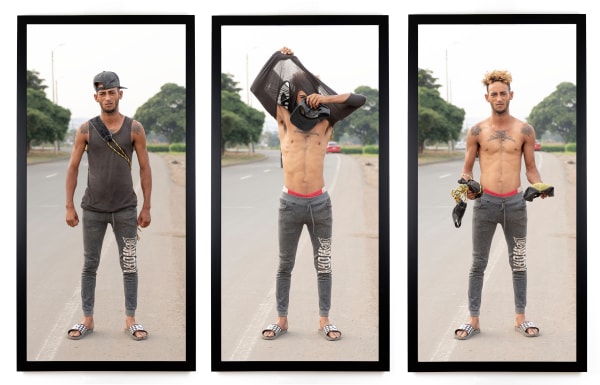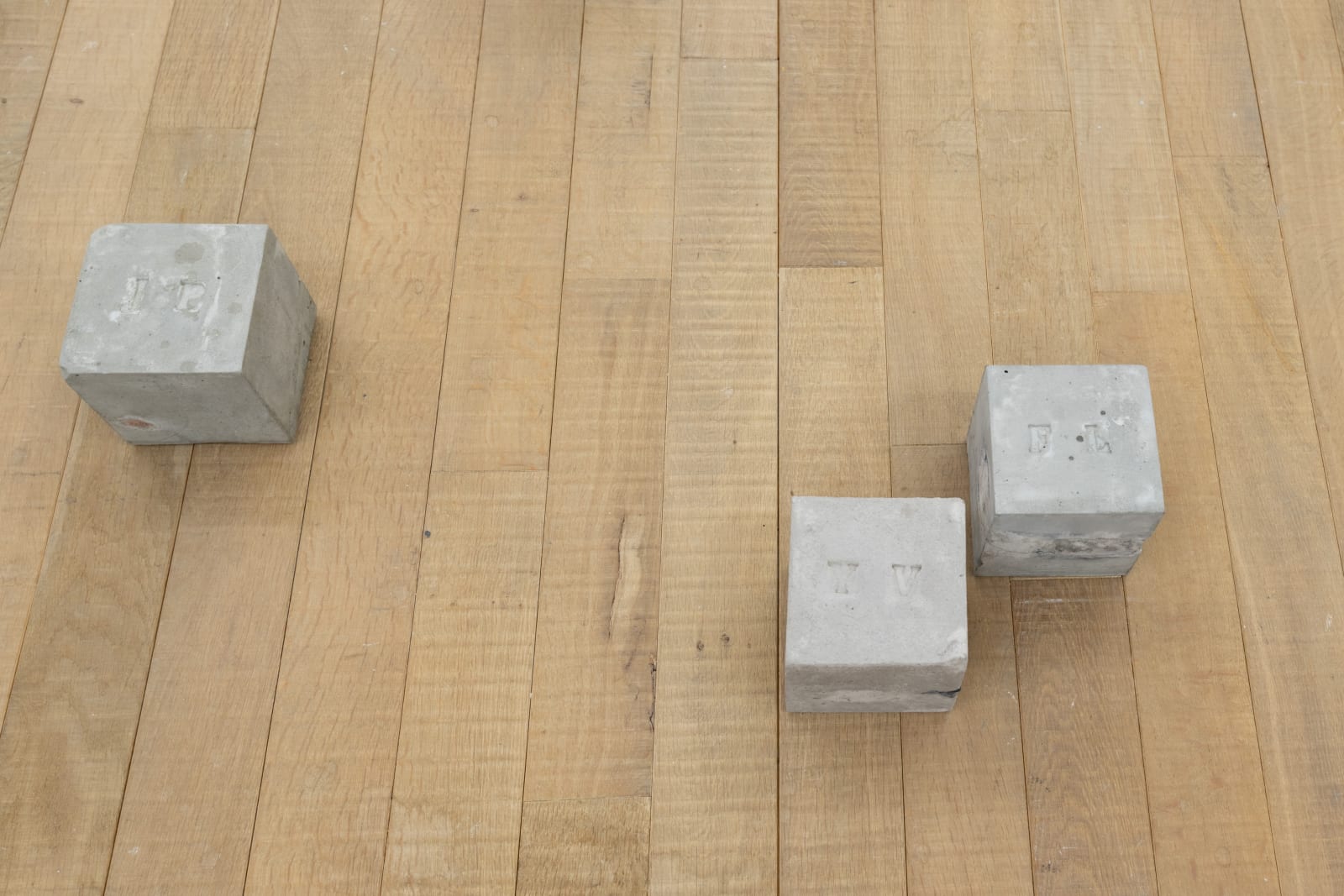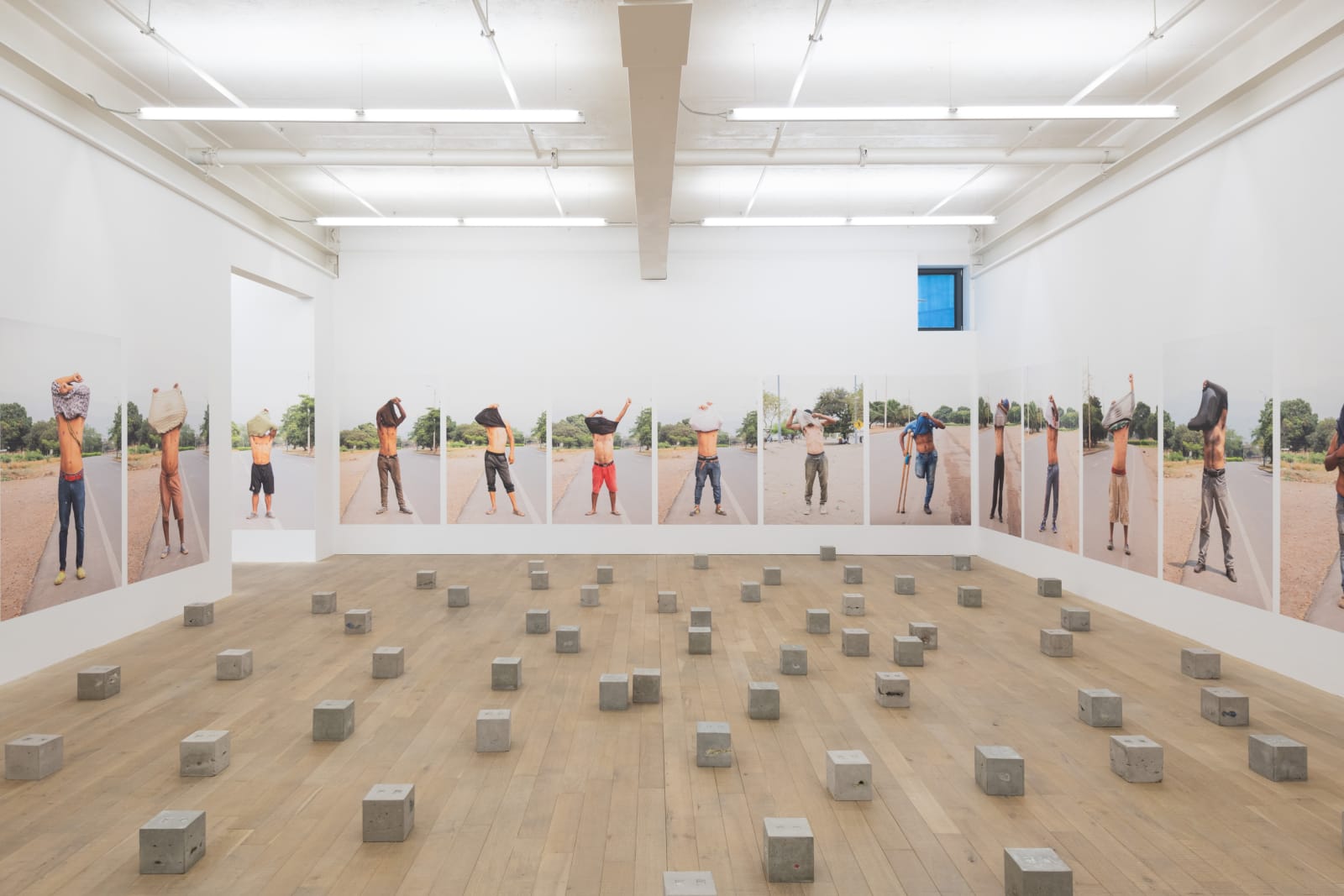Teresa Margolles: EstorboGalerie Peter Kilchmann
Zahnradstrasse, Zurich
Galerie Peter Kilchmann is pleased to present Estorbo, Teresa Margolles' fifth solo exhibition at the gallery. Based on her research in the border region between San Antonio de Táchira, Venezuela, and San José de Cúcuta, Colombia, where the artist had repeatedly resided between 2017 and 2019, Margolles unfolds a profound narrative that explores the sites and consequences of forced migration.
-
 Teresa MargollesEstorbo (Obstruction) II, 2019Installation consisting of 90 concrete cube and color prints (posters), mounted unframed on the wall. Each cube shows the initials of Venezuelan men who have migrated to Cucutá, Colombia, and work as „Trocheros“ (trail-finder and carrier) at the frontier bridge Simón Bolívar. The t-shirts that belonged to these men, soaked with their sweat, have been given to the artist in an act of exchange and cast in the cubes. Each photograph corresponds to one cube.Each cube: 15 x 15 x 15 cm (5 ⅞ x 5 ⅞ x 5 ⅞ in.)
Teresa MargollesEstorbo (Obstruction) II, 2019Installation consisting of 90 concrete cube and color prints (posters), mounted unframed on the wall. Each cube shows the initials of Venezuelan men who have migrated to Cucutá, Colombia, and work as „Trocheros“ (trail-finder and carrier) at the frontier bridge Simón Bolívar. The t-shirts that belonged to these men, soaked with their sweat, have been given to the artist in an act of exchange and cast in the cubes. Each photograph corresponds to one cube.Each cube: 15 x 15 x 15 cm (5 ⅞ x 5 ⅞ x 5 ⅞ in.)
Each photograph: 180 x 120 cm (70 ⅞ x 47 ¼ in.)Unique -
 Teresa MargollesLa Entrega (The Delivery), 2019Installation consisting of 1 concrete cube and 1 color print on cotton paper; the color print shows a Venezuelan man who has migrated to Cucutá, Colombia, and works as „Trochero“ (trail-finder and carrier) at the frontier bridge Simón Bolívar. The t-shirt that belonged to the man, soaked with his sweat, was given to the artist in an act of exchange and cast in the cube. The cube shows the man's initials: E Z.Object: 15 x 15 x 15 cm (5 ⅞ x 5 ⅞ x 5 ⅞ in.)
Teresa MargollesLa Entrega (The Delivery), 2019Installation consisting of 1 concrete cube and 1 color print on cotton paper; the color print shows a Venezuelan man who has migrated to Cucutá, Colombia, and works as „Trochero“ (trail-finder and carrier) at the frontier bridge Simón Bolívar. The t-shirt that belonged to the man, soaked with his sweat, was given to the artist in an act of exchange and cast in the cube. The cube shows the man's initials: E Z.Object: 15 x 15 x 15 cm (5 ⅞ x 5 ⅞ x 5 ⅞ in.)
Photograph: 180 x 120 cm (70 ⅞ x 47 ¼ in.)Unique -
 Teresa MargollesLa entrega (The delivery), 2017-2019Triptych, color prints on cotton paper
Teresa MargollesLa entrega (The delivery), 2017-2019Triptych, color prints on cotton paper
Record of the three phases of the action "La Entrega" carried out on the international bridge Simón Bolívar on the border between Venezuela and Colombia. The action was carried out with Venezuelan migrants who work temporarily on the road carrying goods and people until they have enough money to continue their exodus.180 x 85 cm (70 ⅞ x 33 ½ in.), eachEd. 1/ 3 (+ 1 AP) -
 Teresa MargollesMujeres venezolanas en la frontera con Colombia (Venezuelan women on the border with Colombia), 2018Installation with 1 color print on wallpaper and 1 audio piece, 12:03 min; documentation and testimony resulting from workshops with young Venezuelan mothers held in the area of La Parada, next to the Simón Bolívar International Bridge, Colombia
Teresa MargollesMujeres venezolanas en la frontera con Colombia (Venezuelan women on the border with Colombia), 2018Installation with 1 color print on wallpaper and 1 audio piece, 12:03 min; documentation and testimony resulting from workshops with young Venezuelan mothers held in the area of La Parada, next to the Simón Bolívar International Bridge, Colombia
267 x 401 cm (105 ⅛ x 157 ⅞ in.)Ed. 1/10 (+ 2 AP) -
 Teresa MargollesMujeres venezolanas en la frontera con Colombia (Venezuelan women on the border with Colombia), 2018Color print on cotton paper; record resulting from workshops with young Venezuelan mothers held in the area of La Parada, next to the Simon Bolivar Bridge, Colombia120 x 180 cm (47.2 x 70.9 in.)
Teresa MargollesMujeres venezolanas en la frontera con Colombia (Venezuelan women on the border with Colombia), 2018Color print on cotton paper; record resulting from workshops with young Venezuelan mothers held in the area of La Parada, next to the Simon Bolivar Bridge, Colombia120 x 180 cm (47.2 x 70.9 in.)
128 x 188 cm (50.4 x 74.0 in.), framedEd. 3/6 (+ 1 AP) -
 Teresa MargollesUn país entre dos países (A country between two countries), 2019Single channel video, color, sound, 17:08 min; record from the Simón Bolívar International Bridge at the border between Venezuela and ColombiaEd. 1/ 3 (+ 2 AP)
Teresa MargollesUn país entre dos países (A country between two countries), 2019Single channel video, color, sound, 17:08 min; record from the Simón Bolívar International Bridge at the border between Venezuela and ColombiaEd. 1/ 3 (+ 2 AP) -
 Teresa MargollesAlbum de familia, 2017/ 2018Digital slide show, color, no sound, 8:20 min; the action consisted of taking two polaroids of Venezuelan migrant families while they were crossing the frontier bridge Simón Bolívar towards Colombia. The family kept one and the artist kept the other. The memory of their passage when leaving Venezuela behind is itemized in the polaroid.Ed. 1/ 3 (+ 2 AP)
Teresa MargollesAlbum de familia, 2017/ 2018Digital slide show, color, no sound, 8:20 min; the action consisted of taking two polaroids of Venezuelan migrant families while they were crossing the frontier bridge Simón Bolívar towards Colombia. The family kept one and the artist kept the other. The memory of their passage when leaving Venezuela behind is itemized in the polaroid.Ed. 1/ 3 (+ 2 AP) -
 Teresa MargollesUn país entre dos países (A country between two countries), 2022Performance consisting of the creation of a line of holes in a gallery wall with a drill, performed by three young Venezuelans. One hundred Bolivariano notes, Venezuela's national currency, are to be inserted into the holes.
Teresa MargollesUn país entre dos países (A country between two countries), 2022Performance consisting of the creation of a line of holes in a gallery wall with a drill, performed by three young Venezuelans. One hundred Bolivariano notes, Venezuela's national currency, are to be inserted into the holes.


















